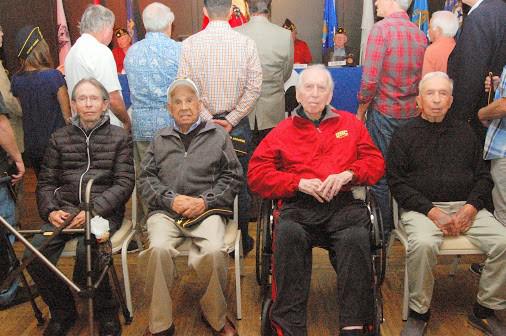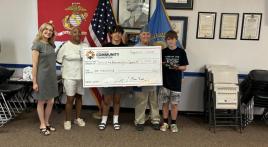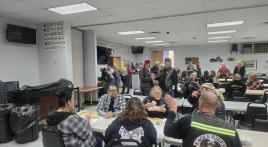Post 291 World War II Inductees' Bios
February, 2015
1. Louis Gantz, US my Air Force. Crewman on B-29 at Alamogordo, NM, 1943-45 assigned to the Manhattan Project.
2. Antonio “Tony” Lujan, PFC, US Army, 101st Airborne Division. Seventh generation Californian from Santa Ana, CA. Drafted in 1943, volunteered for the paratroopers. Assigne3d to the 101st Airborne. In late May, 1944 he was sent with the Division to England to train for the Invasion of Europe. On the evening of June 5th, 1944 he and others were dropped into occupied France near Normandy. The planes missed the Drop Zone and Tony was separated from his unit. He regrouped with a soldier from the 82nd Airborne, and with first light on June 6th, 1944 met up with other groups of paratroopers. The next few days the troopers finally reorganized and made it back to their respective companies. Tony’s regiment was tasked with taking the town of Carentan and linking up the two allied beaches. On June 11th, they met heavy German resistance, and Tony was wounded by a grenade fragment to his foot. He was evacuated to England. His wound healed and he and other paratroopers busted out of the hospital to return to their units.
In September, Tony was deployed with the 101st to Holland. On the morning of September 21st, Tony’s company participated in a combined battalion attack, with Tony’s platoon in the lead. They came under heavy machine gun fire, and Tony’s platoon leader was killed. Ordered to fall back, two wounded men from the 3rd platoon were left behind in “no man’s land. Although the Company Commander denied Tony’s request to retrieve them, Tony and three others went out against orders and retrieved the two men, saving them from certain death.
On December 19th the 101st was sent toward Bastogne, Belgium. On Christmas morning the regiment was attacked by 17 tanks and German infantry. The tank column was behind Tony’s 3rd platoon, but along with C Company and the 705th Tank Destroyers they knocked out and neutralized the tanks and supporting infantry. This battle became known as the Battle of the Bulge.
The company stayed on the line until January 3rd, 1945, when they were relieved. The 101st then began a counter attack out of the once surrounded town of Bastogne. The company took part in heavy combat in the coldest winter on record in Europe. They retook several towns, keeping the Germans on their heels. On the morning of January 17th the company was moving toward Bourcy, Belgium when they encountered several tanks firing at the advancing troopers. Lujan was hit by shrapnel from and 88 round, laying in the snow, unable to move from the waist down. His buddies patched him up and said they would send someone back to get him, but he spent several hours alone while waiting. After several more hours he was rescued, and moved to an aid station. Tony was sent back to the USA, spent time in the hospital recovering from his wounds, and through rehabilitation he regained the use of his legs.
Upon Tony’s discharge from service, he was awarded the Purple Heart and Combat Infantryman Badge.
3. Dr. Arthur “Rodger” Swearingen, PhD, Captain, US Army, 1943-46.
In 1943, Rodger Swearingen left college after two years to enlist in the US Army as an officer in the Intelligence Corps. He attended the Army Intensive Japanese Language School as well as the Intelligence Service Language School. He then was assigned as a Prisoner of War Interrogator in the Counter Intelligence Section of G-2 General Headquarters Armed Forces Pacific Theater. He became one of General Douglas MacArthur’s top aides.
Rodger was with MacArthur on the USS Missouri when Japan surrendered in September, 1945. He remained with G-2 in Japan during the Occupation until his discharge in August, 1946, playing a key role in Intelligence and policy matters with staff. Upon his discharge, he was awarded with the Army of Occupation Medal (Japan), Asiatic Pacific Service Medal, Combat Infantryman Badge, American Campaign Medal, and the World War II Victory Medal.
In 1946, he returned to the University of Southern California to finish his undergraduate degree, and his M.A in 1948 in International Relations. He then attended Harvard University, where he had a fellowship at the Russian Research Center, earning his Ph.D. in 1950, and where he became friends with another graduate student named Henry Kissinger. He returned to USC’s School of International Relations in 1954 as an assistant professor, where he created the field of Soviet policy and world communism in the school. He taught courses and seminars on the subject until his retirement in 1993. During the 1960s, Swearingen created and directed the USC Research Institute on Communist Strategy and Propaganda. Swearingen also brought his knowledge to television, moderating a 35-week documentary entitled “Communism: Myth vs. Reality”, which aired nationwide and on U.S. Armed Services stations abroad.
Swearingen also served as a consultant to the Rand Corporation for 14 years, and was a top advisor to his Harvard classmate Secretary of State Dr. Henry Kissinger through the 1970s and 1980s. He accompanied Dr. Kissinger on numerous trips to the Soviet Union and China. He has authored or edited more than ten books on Communism, Soviet, and Asian policy.
4. Edward Stapleton, First Lieutenant, US Army Air Force, 1943-45.
Ed Stapleton joined the Army Air Force as an officer in 1943, and became a B-17 pilot. He flew numerous missions over Germany during the intense bombing of the country in 1944-45. He and his crew were shot down over Germany by antiaircraft fire, was captured, and sent to Stalag Lufte 3, where he was held as a prisoner of war for a year. This Stalag would later be the Stalag in the movie “The Great Escape.” He was freed after the Liberation of Europe. Upon his discharge, he was awarded the Air Medal with an Oak Leaf Cluster, and the Purple Heart.





